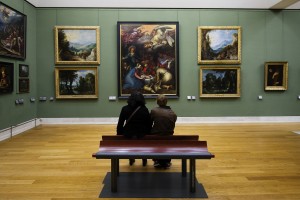Large-scale, randomized-control studies – the gold standard of science, regarded as the best way to demonstrate that one thing actually causes another – are extremely rare in the arts education field, given ethical restrictions on experimenting on kids and the subjectivity of so many things related to the arts. So when researchers working with the Crystal Bridges Museum of American Art announced the results of such a study last fall, the art and mainstream media all rightly sat up and took notice. “Art Makes You Smart,” declared the New York Times headline, barely resisting an exclamation point and, perhaps inevitably, getting the findings wrong – though the enthusiasm for a thoughtfully designed study is certainly justified.
Crystal Bridges is an ambitious new museum of five centuries of American art located in Bentonville, Arkansas and funded primarily by Alice Walton, heir to the Walmart fortune. When the museum opened in 2011, it invited elementary schools in the area to apply for all-expenses-paid class field trips to the museum, including structured tours focusing on five paintings and an hour’s worth of instructional materials for classroom use by the teachers. All of the eligible schools were given trips – but they were assigned by lottery to time slots over the course of a year, which gave University of Arkansas scholars Jay P. Greene, Brian Kisida, and Daniel H. Bowen a top-shelf research opportunity. They gave the same assessment of cognitive and interpersonal skills to two groups of students: one that had already taken their field trips, and another that would take their field trips the following semester. By matching similar groups to one another and using regression analysis to control for variables like demographics and poverty, Greene and company were able to isolate the effect of the visits more rigorously than is usually possible, and for a population of thousands of students.
So what good does a field trip to an art museum do? Researchers catalogued a range of benefits for those who went, ranging from critical thinking skills to measures of tolerance and “historical empathy,” but perhaps the most striking finding is how magnified those benefits were across the board for children from schools in rural areas and serving low-income populations, with effect sizes double or triple those of other students. In fact, most of the positive impact from these field trips accrued to students who had never been to Crystal Bridges before, whereas “much smaller or null effects” were observed in relatively more privileged students who presumably have easier access to enriching experiences like this one.
The report’s strongest finding suggests that it boosts attentiveness to visual detail, at least for a little while. As part of the assessment, students in both treatment and control groups were shown this rather eerie painting, which they hadn’t been exposed to as part of the study, and asked to write about what they thought was going on. Their essays were scored independently by two researchers for evidence of critical thinking using a method designed by scholars at the Isabella Stewart Gardner Museum; basically, the readers added up instances of elements like “observing,” “interpreting,” “evaluating,” and “flexible thinking.”
For rural and poor students in particular, the field trip was correlated with higher critical thinking scores, and the increase was largely driven by more instances of “observing,” meaning that these kids cited more details in their analyses of the painting. The researchers bill this effect bluntly as enhanced critical thinking, but their other findings, which were less pronounced, suggest that something more specific may be going on. Students who had visited the museum were also more likely to try to imagine what people depicted in art were thinking (part of the authors’ measure of “historical empathy”) and less likely to want to censor anti-American art (“tolerance”). At least for a few weeks after visiting, when the assessments were administered, museums seem to encourage students to take art on its own terms: they look more closely; enter the world of a painting more fully; and suspend their prejudices more effectively. This is the state of mind that makes critical thinking – not to mention understanding and appreciation of alternative viewpoints – possible.
And from all appearances, kids love it. Not only were students who had been on a field trip more likely to say that they find art museums interesting and fun, they actually acted on this belief. All of the students were given coupons to attend a special exhibition at the museum with their families for free in the six months following the study; having visited with their class made them 18% more likely to take advantage.
Crystal Bridges now has a $10 million endowment for school visits. Rigorous studies along these lines would be a worthwhile use for what would amount to a very modest portion of the funding that this and other museums set aside for arts education. Art may or may not make us smart, but research can certainly make us smarter.
(Read our full capsule review of “The Educational Value of Field Trips” in Createquity Insider.)
